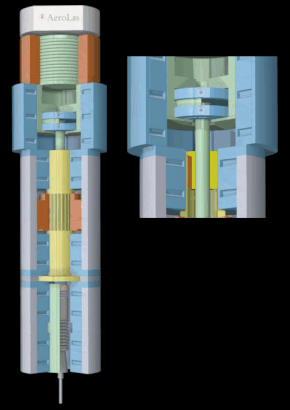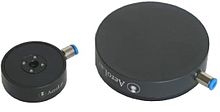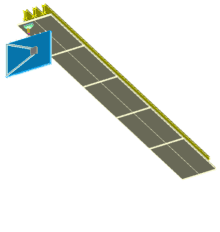

This article needs additional citations for verification. Please help improve this articlebyadding citations to reliable sources. Unsourced material may be challenged and removed.
Find sources: "Air bearing" – news · newspapers · books · scholar · JSTOR (October 2013) (Learn how and when to remove this message) |
Air bearings (also known as aerostaticoraerodynamic bearings) are bearings that use a thin film of pressurized gas to provide a low friction load-bearing interface between surfaces. The two surfaces do not touch, thus avoiding the traditional bearing-related problems of friction, wear, particulates, and lubricant handling, and offer distinct advantages in precision positioning, such as lacking backlash and static friction, as well as in high-speed applications.[1] Space craft simulators now most often use air bearings[2] and 3-D printers are now used to make air-bearing-based attitude simulators for CubeSat satellites.[3]
A differentiation is made between aerodynamic bearings, which establish the air cushion through the relative motion between static and moving parts, and aerostatic bearings, in which the pressure is being externally inserted.
Gas bearings are mainly used in precision machinery tools (measuring and processing machines) and high-speed machines (spindle, small-scale turbomachinery, precision gyroscopes).

Gas-lubricated bearings are classified in two groups, depending on the source of pressurization of the gas film providing the load-carrying capacity:
Hybrid bearings combining the two families also exist. In such cases, a bearing is typically fed with externally-compressed gas at low speed and then relies partially or entirely on the self-pressurizing effect at higher speeds.
Among these two technological categories, gas bearings are classified depending on the kind of linkage they realize:

The main air bearing types fall under the following categories:
| Gas Bearing Type | Technology | Description |
|---|---|---|
| Aerostatic | Porous Media | Gas flow is controlled through porous material |
| Micro-Nozzle | Gas flow is controlled through micro-sized holes | |
| Orifice Type | Gas flow is controlled through holes and grooves | |
| Air caster | Gas flow is controlled through an air bag | |
| Aerodynamic | Foil bearing | Bearing surface is flexible, allowing large displacement and providing a good stability. |
| Spiral groove bearing | Gas film is pressurized by grooves machined on one of the surfaces, achieving high load capacity and stability. The usual groove patterns are herringbone-shaped, spiral or straight (step bearings) |
Pressurized gas acts as a lubricant in the gap between bearing moving parts. The gas cushion carries the load without any contact between the moving parts. Normally, the compressed gas is supplied by a compressor. A key goal of supplying the gas pressure in the gap is that the stiffness and damping of the gas cushion reaches the highest possible level. In addition, gas consumption and uniformity of gas supply into the gap are crucial for the behaviors of aerostatic bearings.
Supplying gas to the interface between moving elements of an aerostatic bearing can be achieved in a few different methods:[4]
There is no single best approach to feeding the film. All methods have their advantages and disadvantages specific to each application.[5]
Dead volumes refer in particular to chambers and canals existing in conventional aerostatic bearings in order to distribute the gas and increase the compressed pressure within the gap. The cavity inside porous (sintered) gas bearings are also attributed to dead volume.[6]

With conventional single nozzle aerostatic bearings, the compressed air flows through a few relatively large nozzles (diameter 0.1 – 0.5 mm) into the bearing gap. The gas consumption thus allows only some flexibility such that the bearing's features (force, moments, bearing surface, bearing gap height, damping) can be adjusted only insufficiently. However, in order to allow a uniform gas pressure even with only some nozzles, aerostatic bearing manufacturers take constructive techniques. In doing so, these bearings cause dead volumes (non-compressible and thus weak air volume). In effect, this dead volume is very harmful for the gas bearing's dynamic and causes self-excited vibrations.[7]
The pre-pressured chamber consists of a chamber around the centralized nozzle. Usually, this chamber's ratio is between 3% and 20% of the bearing's surface. Even with a chamber depth of 1/100 mm, the dead volume is very high. In the worst cases, these air bearings consist of a concave bearing surface instead of a chamber. Disadvantages of these air bearings include a very poor tilt stiffness.[8]
Typically, conventional aerostatic bearings are implemented with chambers and canals. This design assumes that with a limited amount of nozzles, the dead volume should decrease while distributing the gas within the gap uniformly. Most constructive ideas refer to special canal structures. Since the late 1980s, aerostatic bearings with micro canal structures without chambers are manufactured. However, this technique also has to manage problems with dead volume. With an increasing gap height, the micro canal's load and stiffness decreases. As in the case of high-speed linear drives or high-frequency spindles, this may cause serious disadvantages.[9]


Laser-drilled micro nozzle aerostatic bearings make use of computerized manufacturing and design techniques to optimize performance and efficiency. This technology allows manufacturers more flexibility in manufacturing. In turn this allows a larger design envelope in which to optimize their designs for a given application. In many cases engineers can create air bearings that approach the theoretical limit of performance. Rather than a few large nozzles, aerostatic bearings with many micro nozzles avoid dynamically disadvantageous dead volumes. Dead volumes refer to all cavities in which gas cannot be compressed during decrease of the gap. These appear as weak gas pressure stimulates vibration. Examples of the benefits are: linear drives with accelerations of more than 1,000 m/s² (100 g), or impact drives with even more than 100,000 m/s² (10,000 g) due to high damping in combination with dynamic stiffness; sub-nanometer movements due to lowest noise-induced errors; and seal-free transmission of gas or vacuum for rotary and linear drives via the gap due to guided air supply.
Micro-nozzle aerostatic bearings achieve an effective, nearly perfect pressure distribution within the gap with a large number of micro nozzles. Their typical diameter is between 0.02 mm and 0.06 mm. The narrowest cross-section of these nozzles lies exactly at the bearing's surface. Thereby the technology avoids a dead volume on the supporting air bearing's surface and within the area of the air supplying nozzles.
The micro nozzles are automatically drilled with a laser beam that provides top-quality and repeatability. The physical behaviors of the air bearings prove to have a low variation for large as well as for small production volumes. In contrast to conventional bearings, with this technique the air bearings require no manual or costly manufacturing.
The advantages of the micro-nozzle air bearing technology include:
Some of these advantages, such as the high flexibility, the excellent static and dynamic properties in combination, and a low noise excitation, prove to be unique among all other aerostatic bearings.[10][11]

Standard air bearings are offered with various mountings to link them in a system:

Gas-lubricated bearings are usually modeled using the Reynolds equation to describe the evolution of pressure in the thin film domain. Unlike liquid-lubricated bearings, the gas lubricant has to be considered as compressible, leading to a non-linear differential equation to be solved. Numerical methods such as Finite difference methodorFinite element method are common for the discretization and the resolution of the equation, accounting for the boundary conditions associated to each bearing geometry (linear-motion, journal and thrust bearings). In most cases, the gas film can be considered as isothermal and respecting the ideal gas law, leading to a simplification of the Reynolds equation.





Even for movements which cause damage due to disruptive wear with roller bearings, lifetimes of the drive systems are unlimited.
In order to provide confidence and for the first investigations, an initial conversion from a conventional oil-guided turbo charger into air-guided was done. For a real future version, the use of results obtained from high-temperature solutions, mass products (proved production costs) and high-frequency spindles (know-how of dynamic background) will be very helpful.
In terms of the measurement of wafers and flat panels, it is very important to place the sensor chip precisely and without any contact along the surface. Therefore, the chip is integrated directly into the bearing's surface. The maximum distance tolerance to the surface which refers to the gap variation of the air bearing, is smaller than 0.5 μm. When placing the air bearing with the sensor chip, they must not touch the wafer surface being measured. As for the up-and-down movement, a pneumatic piston is used which is, for repeatability reasons, also air-guided. The preload of the air bearing and thus the gap height are also adjusted with this piston.
For the electrical testing of wafers the chuck can be lifted stick-slip-free up to 3 mm. The needed contact force for the probe is adjustable and independent from stroke. The lift drive is based on a voice coil motor; the guidance is air-guided. An air-guided pneumatic piston between the chuck and the drive limits the contact force.
The filigree structure enables through light measurements for the 300 nm chip production with the utmost precision of less than 1 nm. In particular, the air bearings are designed for lowest air consumption with the highest stiffness.
The High-accelerated Doppler drive supports and guides a carbon fiber mirror (surface 500 mm x 250 mm) with an acceleration of up to 300 m/s² and a flexible movement profile with high precision. The solution consists of an air-guided drive: The beam (length 900 mm), which is fixed at the mirror, is manufactured of carbon fibre and carries the magnets of the linear motors. Cables/tubes (motor, air bearing, measurement system) do not move in order to avoid breakages due to high load cycles. The air-bearings are absolutely insensitive against geometric fluctuation as a result of a temperature change.[15]
Beside the performance, the reliability is extremely important for a production machine. The air-guided solution is designed to be statically determined. The iron-core linear motor and piston bearings achieve the preload for the air bearings. Thereby, the drive is easy to assemble and insensitive against geometric variations, for instance through temperature influences or the disposition of the machines.[16]
Fat- and oil-free drives for respirators, stick-slip-free movements of scanners or a high rotary speed of large rotors have all been achieved with air bearings.
High rotary speed (> 5.5 Hz / 330 rpm), low operation costs, no noise, large inner rotor diameter (> 1 m), small weight of rotor and frame, tilt possibility of the rotor as well as a high reliability. Besides a direct drive, a belt drive is also possible.
Primarily, stick-slip-free movements and/or smallest forces are required. The air bearing technology is predestinated for fat/oil-free high-dynamic movements with short strokes.
With air-guided units, optical components can be arranged to have the same diameter on a rotary table. The air bearing with vacuum preload and a constant bearing gap height floats contact-less on top of the rotary table.
The linear slider, which is air-guided and statically determined, guarantees a high-precision positioning of the optical component before grinding. The self-aligning process is done without friction or force. When clamped the component retains its position for further manufacturing in the sub-micrometer-range.
When transporting solar panels for satellites in a launching rocket, these must be folded. After reaching orbit, they unfold via a spring mechanism, weightlessly and without friction. This process requires prior testing on Earth due to reliability reasons. During the testing design, the solar panels are hung on magnetic preloaded air-bearings that compensate for gravity. In doing so, the unfolding movement process is carried out with a minimum friction impact which means that the solar panels are tested at close to reality. Moreover, the design offers absolutely maintenance-free handling with equal sequential movements.
The air-bearing components (diameter 34 mm) with integrated magnets are so small such that they are able to glide contact-free along conventional rolled sheet plates smoothly and with a bearing gap height of about 25 μm. The holding force of an air bearing for one solar panel averages 600 N. This force is achieved by an equal distribution of the load on 16 single air bearing elements. The unfolding process of the solar panels has been developed for an area of 21 m x 2.5 m.
The permanent magnetic preloaded air-bearing guidance system may be used for many types of hanging transportation movements as well as for many other applications, such as for instance for the stick-slip-free positioning of components during assembly.